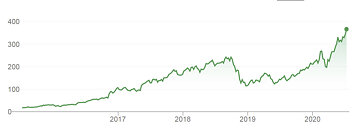Thursday, July 9th 2020

NVIDIA Surpasses Intel in Market Cap Size
Yesterday after the stock market has closed, NVIDIA has officially reached a bigger market cap compared to Intel. After hours, the price of the NVIDIA (ticker: NVDA) stock is $411.20 with a market cap of 251.31B USD. It marks a historic day for NVIDIA as the company has historically been smaller than Intel (ticker: INTC), with some speculating that Intel could buy NVIDIA in the past while the company was much smaller. Intel's market cap now stands at 248.15B USD, which is a bit lower than NVIDIA's. However, the market cap is not an indication of everything. NVIDIA's stock is fueled by the hype generated around Machine Learning and AI, while Intel is not relying on any possible bubbles.
If we compare the revenues of both companies, Intel is having much better performance. It had a revenue of 71.9 billion USD in 2019, while NVIDIA has 11.72 billion USD of revenue. No doubt that NVIDIA has managed to do a good job and it managed to almost double revenue from 2017, where it went from $6.91 billion in 2017 to $11.72 billion in 2019. That is an amazing feat and market predictions are that it is not stopping to grow. With the recent acquisition of Mellanox, the company now has much bigger opportunities for expansion and growth.
If we compare the revenues of both companies, Intel is having much better performance. It had a revenue of 71.9 billion USD in 2019, while NVIDIA has 11.72 billion USD of revenue. No doubt that NVIDIA has managed to do a good job and it managed to almost double revenue from 2017, where it went from $6.91 billion in 2017 to $11.72 billion in 2019. That is an amazing feat and market predictions are that it is not stopping to grow. With the recent acquisition of Mellanox, the company now has much bigger opportunities for expansion and growth.


136 Comments on NVIDIA Surpasses Intel in Market Cap Size
Now if you need me to talk like a lawyer with 100% accuracy in what I am saying, and no freedom in what someone should consider of having in an honest dialog and not in a stupid brainless efford to just pass his opinion, we can continue in Greek. I am flount in Greek, I am just average at best in English.You can keep posting bullshits(your word) if that makes you feel better. Nvidia locked PhysX when there was no compatibility problems to do so. Let me show you something and that will be my last post here. As I said you are a waste of time. Wasting time in weekend is a totally different thing than wasting time in workdays.
Here is that bone you said before. Newer Nvidia drivers WITHOUT a lock with HARDWARE PhysX running while an AMD GPU is PRIMARY.
PS. It's good that hardware physics didn't became the standard. Today the CPU is the system part that is underutilized in modern demanding titles, not the GPU. So, throwing more at the GPU it's not exactly the best idea today.